Director(s) Toru Osawa Artist(s) Tetsuji Tanaka Initial release date 23 May 1989 Genre Adventure game | Producer(s) Gunpei Yokoi Composer(s) Kenji Yamamoto Publisher Nintendo | |
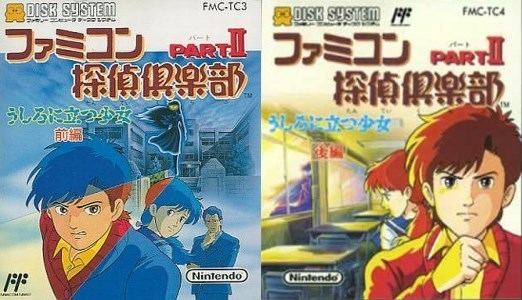 | ||
Writer(s) Nagihiro Asama
Yoshio Sakamoto Release date(s) 1989
Famicom Disk System (FDS)
Disk Card 1
JP: May 23, 1989
Disk Card 2
JP: June 30, 1989
Super Famicom (SFC)
JP: April 1, 1998
Game Boy Advance
JP: August 10, 2004
Wii Virtual Console
SFC version
JP: April 30, 2008
FDS version
JP: December 22, 2009
Wii U Virtual Console
SFC version
JP: July 31, 2013 Platforms Family Computer Disk System, Wii, Super Nintendo Entertainment System, Game Boy Advance Developers Nintendo, Tose, Nintendo Research & Development 1 Designers Yoshio Sakamoto, Gunpei Yokoi, Satoru Okada Similar Shin Onigashima, It's Mr Pants, Kung Fu Chaos, Libble Rabble, Baraduke | ||
Famicom tantei club part ii ushiro ni tatsu sh jo part 1
Famicom Tantei Club Part II: Ushiro ni Tatsu Shōjo (ファミコン探偵倶楽部PartII うしろに立つ少女, "Famicom Detective Club Part II: The Girl who Stands Behind") is a text-based adventure game released by Nintendo in 1989 for the Family Computer Disk System. The original version was released in two discs in 1989, and the game was ported to the Super Famicom and the Game Boy Advance several years later. The Super Famicom version was released in Japan for the Wii's Virtual Console on April 30, 2008, and Wii U's Virtual Console on July 31, 2013. The Famicom version was released for the Virtual Console on December 22, 2009. Neither version of the game was ever released outside Japan, although an English translation patch has been released by the translation group Demiforce for the enhanced Super Famicom version.
Contents
- Famicom tantei club part ii ushiro ni tatsu sh jo part 1
- Famicom tantei club part ii ushiro ni tatsu sh jo part 3
- History
- Gameplay
- Setting
- Prologue
- Main plot
- Epilogue
- The Tale of the Girl in Back
- Characters
- Version differences
- Graphics
- Legacy
- References
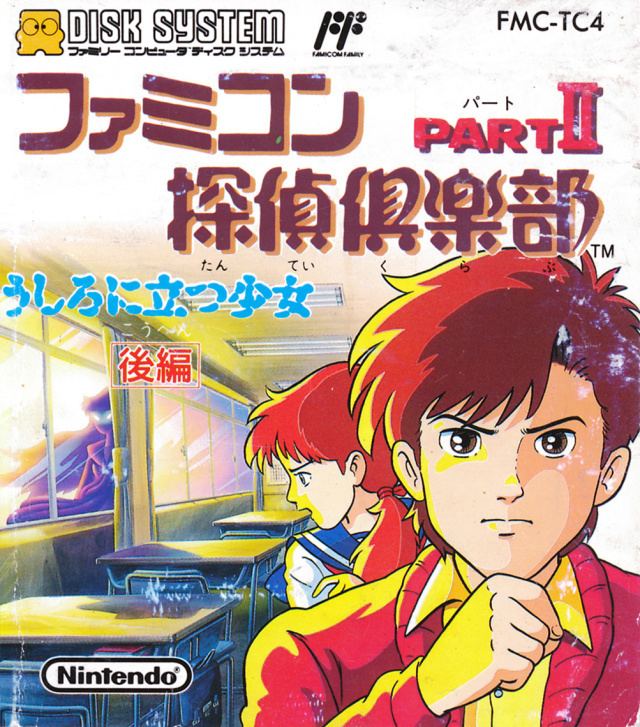
Famicom tantei club part ii ushiro ni tatsu sh jo part 3
History
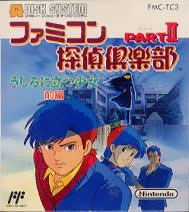
Ushiro ni Tatsu Shōjo is the successor of and a prequel to Famicom Tantei Club: Kieta Kōkeisha, and is the second game of the Famicom Tantei Club series. Its scenario was written by Nagihiro Asama, based on the concept by Yoshio Sakamoto. Kenji Yamamoto composed the game music. The popularity of Part I: Kieta Kōkeisha prompted the release of this sequel, which employed the similar graphic-adventure gameplay. The game was re-released on the Nintendo Power cartridge rewriting service in 1998 with improved graphics and sound, and the Disk System version was released on the Game Boy Advance in 2004 as part of the Famicom Mini series. The murder and smoking scenes resulted in a CERO (ages 15+) rating for the GBA release, making it the first Nintendo title to receive a parental advisory rating.
Gameplay
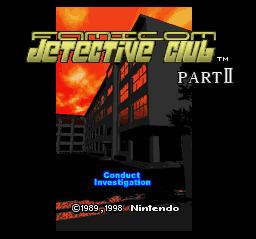
The objective is to solve two cases; the murder of a schoolgirl investigating her school's ghost story, and an older murder nearing legal expiration. Like the previous game in the series, the game progresses as the player chooses from a set of commands displayed on a menu. These commands are used to interact with other characters and the game's environment, examine clues, or review facts. The results of choosing each command are displayed in the text.
Setting

The game's narrative presumably takes place in modern day Japan. Most of the story takes place in a suburban town, where Ushimitsu High School is located. Nearby is a downtown galleria, housing a subway station, a nightclub, and a bar; the player will also reach the "Sambora Bar & Saloon" at a nearby town, contactable in the game by the phone number "007-1234". Ryoko's house is in this same town. Yoko's house and Tazaki's and Goro's apartments are also visited as well. The past Kaneda residence and snack bar were in this same town as well. When the protagonist needs to search for Ayumi, he will need to visit Tazaki's mother's small fishing village of Marufuku.
Prologue
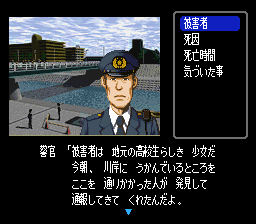
The prologue scene depicts an autumn night "3 years ago" - a 15-year-old boy (the protagonist of the game) on the run from two police officers. A man, respected by the police, decides to care of the situation by himself. The man takes the boy to a coffeehouse; the boy ran away from his orphanage to find his parents' whereabouts. The man, a private detective named Shunsuke Utsugi, convinces him to become his assistant.
Main plot
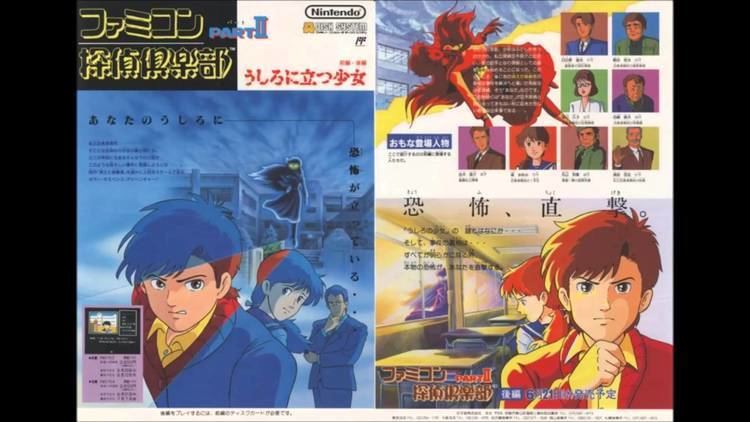
A cutscene tells that "a few months later", Utsugi and the protagonist receive a phone call to check over a crime scene; this starts Chapter 1. The victim is a freshman schoolgirl named Yoko Kojima. Her time of death is estimated to be around 9-10 PM on October 10. Throughout Chapter 1, Chapter 2, and Chapter 3, the protagonist will need to gather information from Ushimitsu High School to solve the Yoko case, and connect it with the Genjiro Kaneda case. Yoko was deep into an investigation of "The Tale of the Girl in Back"; this rumor involves a ghost of a blood-soaked girl that stands behind a student.
The "Girl in Back" story originated 15 years ago, when a schoolgirl of Ushimitsu, Shinobu Asakawa went missing. This was around the same time of the murder of Genjiro Kaneda; that case's statute of limitations was going to expire soon. In Chapter 4, the player will learn more background about the ghost story. Ms. Hayama, a teacher at the school, admits to the protagonist that she started the rumor. On the night of the Kaneda murder, the then sophomore went to the school to get some forgotten homework, but saw the "Girl in Back".
In Chapter 5, Hayama confirms passing by the old school building during the night she saw the "Girl in Back", but the wall was unfinished. During the conversation, the protagonist catches Tazaki eavesdropping. He tries to chase him down, but fails. After he returns to the detective agency, Ayumi gives him a cup of coffee that makes him go unconscious. As this happens, the game flashes back to the previous events.
When he gains his consciousness in Chapter 6, he realizes Ayumi drugged his coffee; a letter from Ayumi says she went to track down Tazaki herself. The game then depicts him searching through a town, and ending up in a downtown galleria. Eventually, he ends up from Tazaki's apartment, to his mother's village, and finally down a cliff, where Ayumi is kept hostage by an unstable Tazaki. He threatens to kill her, but gives up afterward. He confesses about his false alibi and talks of his past. In Chapter 7, the protagonist has the altruistic Urabe admit he lied about Tazaki's alibi, but he showed no regrets. The protagonist will find that many students and teachers - particularly Mr. Hibino - respect Urabe as a fine educator.
Chapter 8 and Chapter 9 provide background information for Shinobu, Urabe, and Goro. The protagonist notices a portrait of Shinobu in the school; the painter, Ryoko Katsuragi, tells the protagonist about Shinobu's personality. Yoko and Shinobu were also cousins. When the protagonist arrives at Goro's apartment, the game presents a scene of Goro getting murdered. The protagonist realizes that Goro was the man Urabe hanged out with at the galleria. He was holding a pen with the initials "T.U."; these match the initials of Teruhiko Uchida and Tadashi Urabe.
Chapter 10 elaborates more on Shinobu's friend, whose last name was Uchida. Sayaka Ishibashi tells the protagonist that the Uchida boy was indeed Teruhiko's son, Tatsuya. This boy later turns out to be Tatsuya Hibino. Hibino tells the protagonist about how he developed his father-son relationship with Urabe. He also shows his extreme resentment towards the Kanedas. He has no alibi for the Goro murder, but throws a temper tantrum when the protagonist considers Urabe a suspect.
Chapter 11 makes up the final chapter of the game's narrative. Conversing with Hayama, the protagonist realizes Urabe was never on any business trip, as he claimed before. When she went to school on the night of the Kaneda murder, through the window of the old school building did she see the bloody girl - this was likely Shinobu. Tazaki reveals that on that night he was indeed plastering the wall of the old school building, but he took a break. The next morning, it looked like someone had used his tools.
Back at the detective agency, a resentful tipster calls to tell that the "lowlife" was at the school. Ayumi was taking a make-up test for Hibino before they went outside to meet the protagonist. The three break through the door into Urabe's office, and the player is shown a visual of the suicided Urabe. Urabe had left a suicide letter; on it, he shamefully confesses as the serial killer.
The next scene reveals the shattered Hibino as the serial killer. During flashback cutscenes, Hibino makes detailed confessions of his murders. After confessing about Genjiro, Shinobu, Goro, and Yoko, he tries to slash the cornered protagonist and Ayumi in the hallway with the giant mirror. Instead, he ends up shattering it into pieces. It reveals the corpse of Shinobu; as police, Maruyama, and Utsugi arrive, Ayumi faints.
After the climactic revelations, the game cuts back to the agency; Utsugi and the protagonist discuss their findings. Afterwards, Utsugi introduces Ayumi as an official assistant of his. When the protagonist asks Utsugi about the "T.U." pen, he does not answer why it didn't read "T.H." instead - but he and Ayumi go out to eat, leaving the protagonist behind. The screen cuts to black, as he is left thinking about Urabe's covering up his friends' mistakes and the true meaning behind "T.U."; he thinks it could mean Tatsuya Urabe,showing how Tadashi considered Tatsuya to be his son (hypothetically) .
Epilogue
After the credits roll, the game goes into its epilogue, "two years later." Zenzou Tanabe calls the Utsugi Detective Agency over to his Myojin Village. The protagonist goes out to the village, while leaving behind Ayumi. The game's plot would continue into Famicom Tantei Club: The Missing Heir; this game is chronologically a prequel to the first game in the series.
"The Tale of the Girl in Back"
This ghost story circulates in Ushimitsu High School; it serves as the primary plot device in the game (along with the two cases investigated), and the game's subtitle derives from this. It originates "15 years ago", when the then schoolgirl Hayama saw a bloody girl - Shinobu Asakawa - through a window of the old schoolhouse. The Girl in Back haunts a student by calling him/her from behind, presenting herself to the haunting victim as a girl completely covered in blood. A variation of this story tells that she first calls a student behind; after the victim searches, he/she will find the Girl in Back in front of him/her. One version of the story says she appears in hallways; another version says she appears in bathrooms.
Characters
The protagoinst is a 15-year-old boy, whom Private Detective Shunsuke Utsugi takes in as his apprentice. The protagonist ends up handling a case of the murder of a 16-year-old freshman, Yoko Kojima. This connects to the murder of Genjiro Kaneda, a swindler, and the disappareance of a schoolgirl Shinobu Asakawa at the same time. This girl's disappareance is the root of a rumor in Ushimitsu High School, the ghost story of the "Girl in Back"; it started by a then-sophomore Hisako Hayama, in-game a biology teacher in the school. Later on in the game, the son of Genjiro, Goro Kaneda, is murdered. With the help of local freshmen Ayumi Tachibana and Hitomi Kawai, the protagonist eventually discovers English teacher Tatsuya Hibino as the true serial killer. However, the school's janitor Toshio Tazaki, and principal Tadashi Urabe, are considered suspects of these killings beforehand.
Version differences
The original Disk System version was released in two separate Disk Cards, released separately from each other. Its music was composed by Kenji Yamamoto, who composed sound and music for Super Metroid and for Metroid Prime 3: Corruption. It utilizes the FDS's extra sound channel for the music.
The SFC remake had improved graphics - directed by Tomoyoshi Yamane, object and Samus designer for Super Metroid and designer for Wario Land 4 and Metroid II: Return of Samus; the remake's music was yet again composed by Kenji Yamamoto. Since the SFC version is on a cartridge instead of a Disk Card, it avoids the load times when saving games and switching between scenes. The SFC version utilized the SFC's 8-channel Sony SPC700, which had more channels than the Famicom's 5-channel Ricoh 2A03 and the FDS's channel together. The SFC version generally had extended remixes all of the original version's songs, and a few extra songs. The game uses either waveforms or white noise to "voice" the characters. The FDS version's voice waveforms are all the same frequency square waves, but in the SFC version, each character is designated to one of a number of different voice waveforms. In the original FDS version, for the protagonist's search for Ayumi, the game required the player to manually go through the town as a pseudo-3D maze; the SFC version had this trimmed down to just text and visual descriptions.
The SFC version adds a "memo" interface that the player can access throughout most of the game. It can be used to look up information on most of the characters (except the protagonist himself, Utsugi, Maruyama, Fumi Tazaki, and all unnamed characters). At some points, the memo's interface is used to fill in question blanks with the names of the correct characters. The memo is also utilized during most "Review" sessions, where the protagonist reviews on what new information he discovered so far. This version also has a "logbook" feature, which summarizes all story and information gathered so far in a save file.
The SFC remake adds an extra, final part to the ending - a personality assessment for the entertainment of the player, based on the player's actions and patterns. For example, analyzing or touching Yoko's skirt could have the game assume a flirtatious personality. In addition, based on how the character treats Ayumi, the game will determine the protagonist's "compatibility" with Ayumi, out of 20 hearts. Actions with Ayumi and other schoolgirl characters would be used to select who to match with the protagonist - this includes the art club member, a flirtatious schoolgirl, and Ayumi herself.
Graphics
For the SFC version, all of the scenes were redrawn, and some were extended into multiple drawings. Unlike the FDS version's art, directed by Tetsuji Tanaka, the remake uses the SFC's graphical capabilities to execute cinematic techniques, including scrolling, transparency, stylistic, and fading effects. In addition, the SFC versions adds close-ups of characters during specific scenes; examples of this enhancement include Tazaki's holding Ayumi hostage and Hibino's temper tantrum. Flashback sequences are given more detail - for example, the cutscene of Hayama's account of the Girl in Back shows a younger Hayama and the background of the school behind her. Other stylistic changes in the artwork include a blue silhouette of the Girl in Back during a cutscene about the ghost and the sketched style of one of the ending screens. In the original FDS version, some of the anonymous characters cannot be seen; however, the SFC version provides visuals of nearly all anonymous characters the protagonist encounters.
Legacy
"Ayumi Tachibana" appears as a collectible trophy in the Nintendo GameCube title, Super Smash Bros. Melee. The game includes a short paragraph explaining that she first appeared in Famicom Tantei Club Part II, which her first appearance was actually in Famicom Tantei Club: Kieta Kōkeisha. It also claims that she solved the murder of "one of her friends" (Yoko) in the first installment, but that was in the second installment, not the first. Contrary to what the description says, Ayumi never opened her own detective agency; at the most, her backstory tells that she opened a school detective club with Yoko, and she becomes an assistant of Utsugi's agency.
